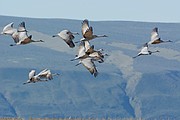After 15 years as volunteers, couple still excited about sandhill cranes
OTHELLO — Chris and Kurt Braunwart have volunteered 15 years at the Sandhill Crane Festival, which will celebrate its 20th anniversary on March 24-26 in and around Othello.
And they’re not tired of it.
The Braunwarts promote the festival any chance they get. They’ll even drive you out to see the early arrivals as the sandhill cranes migrate from their winter home around Lodi, Calif. to Alaska for the process of species renewal.
Sandhill cranes, thousands of them for about a 6-8 week period, stop in Othello to rest, relax and refuel before heading on north. It made sense 20 years ago to feature them in a festival. Now people register months in advance to come and sit through classroom lectures, ride school buses on field trips and enjoy a selection of other tours.
Nobody knows for sure how many cranes make the annual visit to Othello. Kurt has heard estimates of upwards of 35,000.
There are very few routes the sandhill cranes take north. The Pacific Flyway is the most used. And more of them come now than when Kurt was a kid growing up in Moses Lake. There were few farms in the area then and not much reason for the birds to stop.
The earliest Kurt remembers of the cranes is when his dad would call the kids out to watch the birds fly overhead.
“We really didn’t see them because they didn’t stop, but we could hear that screaming sort of sound they make.” Kurt said. “There were no crops. They just flew on by.”
Kurt has learned quite a bit about the sandhill cranes. They migrate to the Alaska tundra for the mating season. They do mating dances, mate for life and fly as families.
As the Othello area became greener and greener because of Grand Coulee irrigation water, crops became varied and bird feed became more plentiful. The Cranes started to make the Othello area a regular stop.
Kurt credits Randy Hill of Vancouver with starting the festival. He was stationed with the U.S. Fish & Wildlife Service when it sponsored the first festival with the help of local volunteers. The USFWS is still a partner.
Chris was out of town for that first festival. Kurt went with his daughter.
“I thought it was going to be some little neighborhood thing,” he said “Both she and I were surprised. So were the organizers. About 400 people came.”
Now it takes 400 volunteers to run the festival. Chris said the Saturday crowd alone tops 1,500 people. She said Jenn Stevenson reported that more than 2,000 people went to the wine tasting at the Old Hotel Art Gallery on Saturday last year.
The gallery and several other entities are part of the festival. Civic organizations offer affordable meals. The Senior Citizen Center makes lunches. There is a spaghetti feed at the Eagles Lodge on Friday night.
The Rotary Club offers a Saturday morning breakfast. There is a Saturday evening banquet catered by Marie Borth’s Classy Country Catering.
The festival has had the same format since it started. It introduces birders and others to the sandhill cranes and also a geologic treasure trove a Central Washington University lecturer refers to as the Disneyland for geology.
The tours go as far east as Palouse Falls, west to the Puget Sound Energy site, south as far as the Hanford Reach and north as far as Grand Coulee.
There were 10 lectures and 10 tours the first year. There will be 46 lectures and 30 tours this year. There was a one-page brochure the first year. Now it has 24 pages and a cover.
“We have a wildlife specialist and an ag specialist on every bus,” Kurt said. “We learned quickly. As we went out to see the birds, people were asking, ‘What’s that (crop).’”
“It has become a three-pronged festival – sandhill cranes, geology and agriculture,” Chris said. “A lot of these people are from Seattle. They’ve never seen a farm.”
Kurt surveys the buses he rides. About half of the visitors are from Seattle. About 10 percent come from outside of Washington. And every year there is at least one person from out of the country
“Some people come specifically for the geology,” Kurt said.





